Before last week’s heat wave started my article, Get Out the Popcorn – NYS Heat Wave Might Affect the Grid, about the potential impact on the New York State grid was published at Watts Up With That. This post summarizes the implications of the heat wave on the grid.
I have followed the Climate Leadership & Community Protection Act (Climate Act)since it was first proposed, submitted comments on the Climate Act implementation plan, and have written over 400 articles about New York’s net-zero transition. The opinions expressed in this article do not reflect the position of any of my previous employers or any other company I have been associated with, these comments are mine alone.
Power Trends
The New York Independent System Operator (NYISO) recently issued its Power Trends 2024
report which is billed as their “annual analysis of factors influencing New York State’s power grid and wholesale electricity Markets”. In the WUWT post I focused on the NYISO Summer 2024 Reliability Outlook chapter. I highlighted the particular concern for heat waves in the following:
For summer 2024, the NYISO expects 34,913 MW of resources available to meet 31,541 MW of forecasted demand under normal conditions. Under extreme summer weather conditions, however, forecasted reliability margins could potentially be deficient without reliance on emergency operating procedures. For example, if the state experiences a heatwave with an average daily temperature of 95 degrees lasting three or more days, demand is forecasted to rise to 33,301 MW, while predicted supply levels are reduced to 34,502 MW. When accounting for the required 2,620 MW of operating reserves that must be maintained, this scenario results in a forecasted reliability margin of -1,419 MW. That reliability margin declines further to -3,093 MW under an extreme heatwave with an average daily temperature of 98 degrees. Under these more extreme summer weather conditions, the NYISO forecasts an available supply of 34,317 MW to meet the required 2,620 MW of operating reserve requirements, plus a forecasted demand of 34,790 MW.
The intent of the article was to alert readers that the extreme summer weather conditions highlighted by NYISO could occur with the heat wave.
Observations
In brief, the June 2024 heatwave came nowhere near the potential deficit criteria. Table 1 shows that the average daily temperature did not exceed 84o F over the last four days. This was not a real stress test for the New York State electric grid.
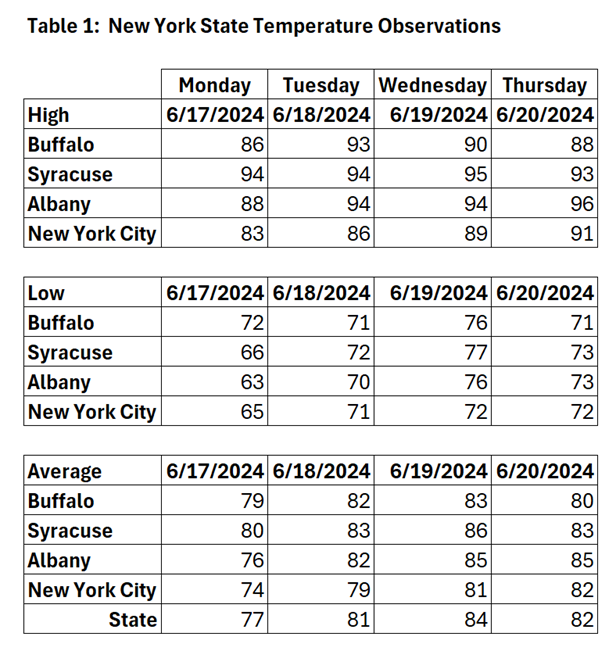
NYISO Fuel Mix
Even though the heat wave did not push the New York grid the fuel-mix load data from the NYISO Real-Time Dashboard provides some interesting information. I have compiled the data for 17-21 June here. The following graph shows the hourly fuel type generation throughout the period. The generator types include “Hydro” that includes pumped storage hydro; “Wind”, land-based wind; “Other Renewables” that covers solar energy, energy storage resources, methane, refuse, or wood; “Other Fossil Fuels” is oil; “Nuclear”; “Natural Gas”; and “Dual Fuel” which are units that burn both natural gas and oil.
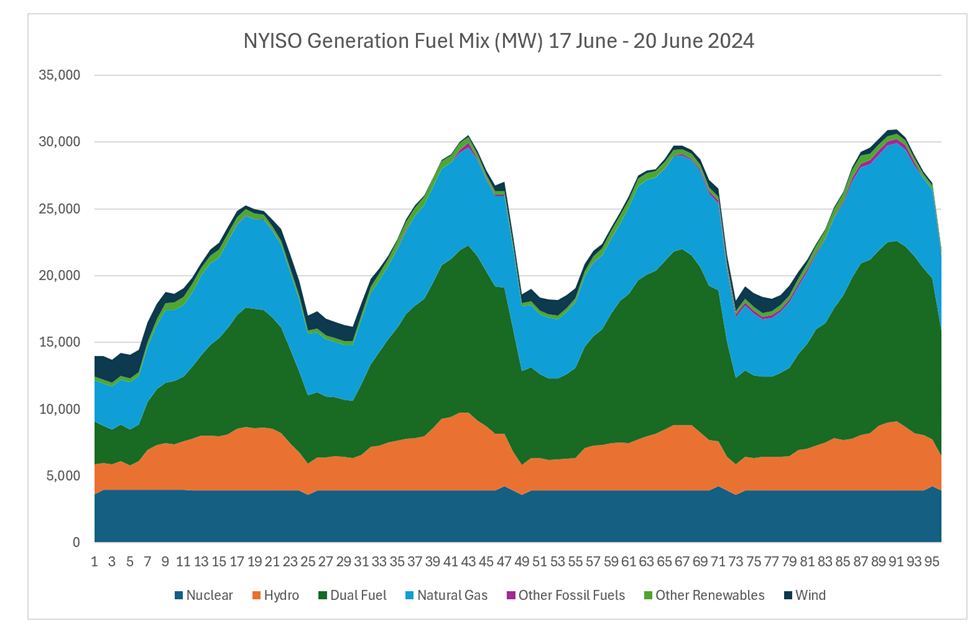
The NYISO Summer 2024 Reliability Outlook expects 34,913 MW of resources available to meet 31,541 MW of forecasted demand under normal conditions. During this period, the maximum hourly generation was 30,525 MW at hour 18 on June 18. There are important considerations relative to the fuel mix at that time.
The following table lists the fuel mix for generating facilities in New York for June 18. NYISO does not track behind-the-meter solar that reduces the load that NYISO must provide. Note that nuclear is constant throughout the day and hydro, dual-fuel, and natural gas increases to match the load peak.
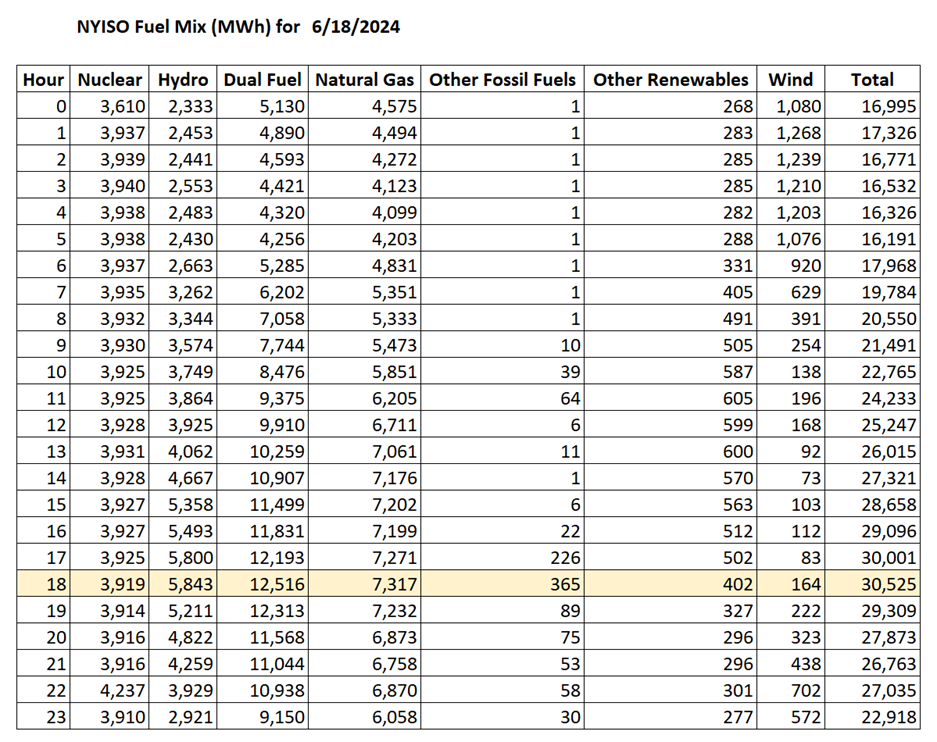
The remaining three categories are of particular interest. The following graph only includes these three categories because they are small relative to the other fuel types.
In the “Other Renewables” categories the Gold Book lists the following capabilities at the end of 2023: utility-scale solar energy 254 MW, energy storage resources 20 MW, methane 104 MW, refuse 239 MW, and wood 56 MW for a total of 653 MW. The graph suggests that solar was providing its peak load during each day. The methane, refuse, and wood generators are dispatched so that they reduce load at night to a little under 300 MW.
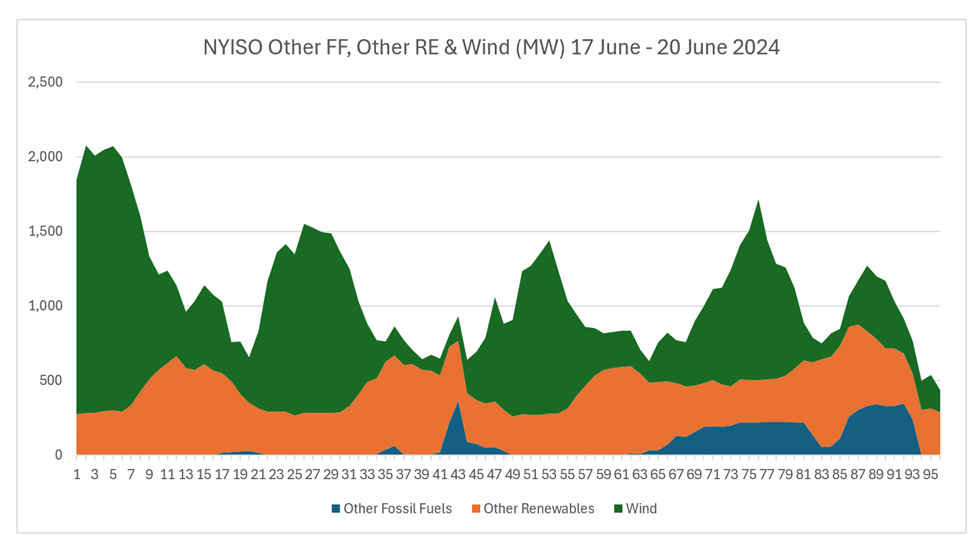
One of the notable features during this period was that the wind resource consistently was lowest during the daily peak load. Despite this result New York is continuing to double down on renewable development. On June 20 the New York State Energy Research & Development Authority announced:
Governor Hochul today announced a new NYSERDA large-scale renewable energy solicitation to deliver clean electricity to New Yorkers. Building on New York’s 10-Point Action Plan , this solicitation seeks proposals for the development of new large-scale land-based renewable energy projects which are expected to spur billions in clean energy investments and create thousands of family-sustaining jobs in the State’s green economy.
Given that when needed most during the peak load observed here that all the New York land-based wind went to very low levels this solicitation will not solve this problem. Higher wind capacity with zero wind resource yields zero electricity.
There is another notable feature of the observed wind resources. The peak winds occurred in the early morning hours which are the lowest load periods. I believe this is a feature of the nocturnal wind pattern. Low-level winds affecting wind turbines increase with height as the effect of surface roughness and atmospheric mixing are reduced. At night the solar surface heating stops and the level of reduced wind speed contracts. This causes the wind speeds to increase and wind energy resources to improve. It also is another load balancing issue that must be addressed for an electric grid that depends on wind power generation.
The last of these three categories illustrates another related issue. The category “Other Fossil Fuels” provides generation for units that are exclusively oil-firing. In New York there are two types of these units – residual oil-fired steam boilers and simple-cycle peaking turbines. All the oil-fired boilers must remain at minimum loads higher than the lowest hourly values listed above to be able to ramp up for the diurnal peak. Therefore, the generation came from simple-cycle peaking turbines. As I have previously explained, New York City peaking turbines are vilified as “the most egregious energy-related example of what environmental injustice means today.” However, the presumption of egregious harm is based on selective choice of metrics, poor understanding of air quality health impacts, and ignorance of air quality trends. I wish I could say that there is no chance that these units will not be shutdown sooner than necessary to mollify Environmental Justice activists who demand it, but I am unconvinced.
Discussion
I am not optimistic that New York State energy policy will be up to the task addressing the future system resources challenge for a zero-emissions electric grid. One of the issues highlighted by the NYISO Power Trends report is illustrated in the following figure from the Power Trends Fact Sheet.
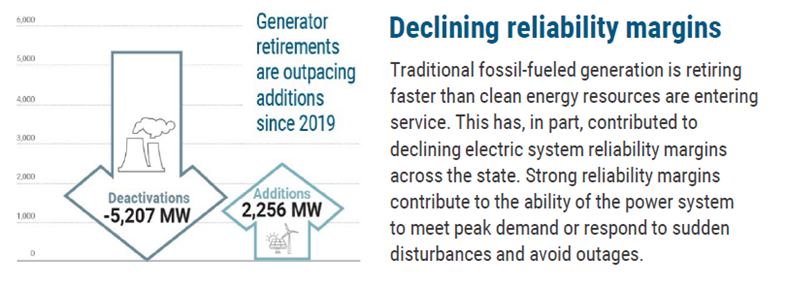
Overall, the capacity reduction from generator retirements relative to additions is 57%. However, if you compare the energy capability of the deactivated generators, especially the 2,000 MW of nuclear power retired, with the addition of primarily solar and wind capacity the energy available to the system is even less.
One other recent development is relevant. The owners of the Danskammer power plant north of New York City have had an application to repower and replace the existing Danskammer generating station with the Danskammer Energy Center, a new state-of-the art, efficient natural gas-fired combined cycle generating unit. Unfortunately, like a couple of other proposals to replace old fossil generating units with much cleaner and modern units, the New York State Department of Environmental Conservation has denied the permits to construct basically because there are Climate Leadership & Community Protection Act mandates coming. The fact that there is no feasibility analysis that proves that those mandates can be achieved was ignored. After years of court battles the developers gave up and withdrew their application this week. As a result, the electric system will continue to rely on aging and dirtier fossil generation for however long it takes for the State to figure out that existing technology is incapable of replacing fossil fired peaking power plants needed to keep the lights on.
Conclusion
The latest heat wave in New York State did not exceed the criteria determined by the NYISO for potential problems. Nonetheless, the facts that wind resources were a fraction of potential capacity during the peak hours and the grid relied on peaking power plants that environmental activists demand be shut down as soon as possible suggest that the potential problem is not going to go away anytime soon. Stay tuned.
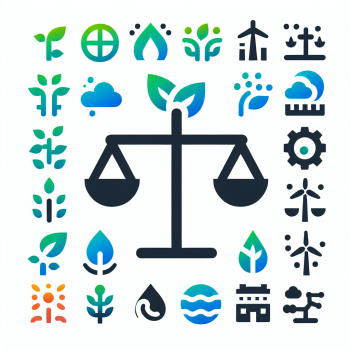

Well said! You can’t beat natural gas plants for their flexibility. We had the same issues in Ontario in the same timeframe with very little wind and those natural gas plants came to the rescue!
LikeLiked by 1 person